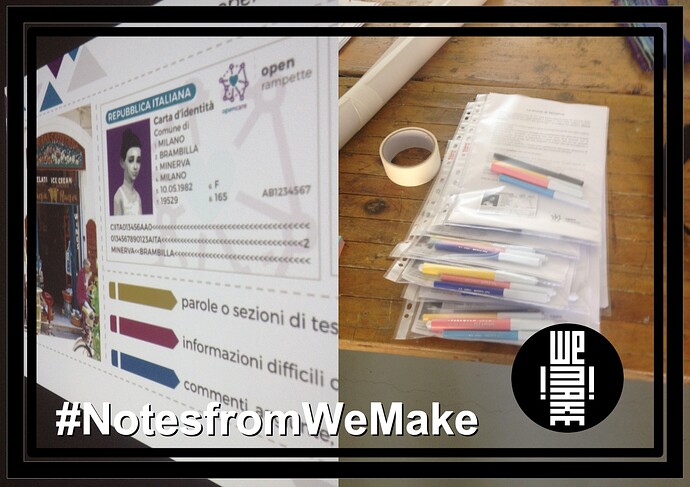The meeting with citizens like @Francesco_Maria_ZAVA , @Rossana_Torri from the Municipality of Milan, the Trade association Confcommercio, shops owners and the openrampette team of WeMake Fab lab took place on may 23th at La Stecca facility in Milan.
The openrampette team worked for weeks in order to plan and deliver a well balanced session that included hard design needs by a user research approach and an easy, neat approach meant for anyone.
As the participants arrived, they gathered in 4 informal groups to have some chatting.
@Costantino introduced the activity, while @ChiaraFrr -both from WeMake- presented all the steps of the activity for the roleplay based on the idea that a winery owner (Minerva) must undergo the procedure by filling forms and, in a further moment, highlight by different colors, gaps and hard-to-understand parts of the form. The goal was to understand more on how about enforcing the regulations about an access ramp before the shop that can be removed when is not needed. The participants committed nicely by discussing in couples. There was a good collaborative and motivated atmosphere around.
As facilitators, the openrampette team walked around to help and suggest to the participants how to tackle certain details. A load of pictures was taken around to witness the session. By my side, I was interested in taking pictures as well, even though my perspective was different, more focused on how the session was enacted and how a intersubjective level could emerge from and by the interaction of actors.
Even though the time was up, participants were willing to discuss more on biases on the forms and about the procedure itself.
There was a break with drinks and food for a evening snack. Then, the openrampette team collected the filled forms by the participants and the idea was to find out for patterns and common salients. The paper sheets were layed on the floor and a feedback was given, while @silviad.ambrosio -another openrampette teamer- patched post-its on a frame poster. The most important part followed. Costantino showed some slides about the contradictions and unclear steps in the procedure, like that -for instance- the ramp “bell” to call who is inside the shop, is mentioned only once on the website of the Municipality and is an important part needed to communicate between the customer, that might be someone who needs to access by a wheelchair, or a mother with a baby buggy.
Now, some considerations…
First of all, a kind of participatory assessment, based on a broad and heterogeneous participation was appreciated also by @alessandro_contini -the designer in charge of the user research meant for shop owners only that will follow this event. What emerged are unexpected cases in-between and common and shared interests among stakeholders. The social dimension emerged as a shared need to construct a substantial and workable objectivity, by a keen and multidimensional analysis of the formal objectivity embedded in the procedure and the script articulated in the fields of the form. What citizens could make visible where aspects of the dimensions for access that usually remain invisible when filling a form or being counseled by a technical advisor.
Makers have a peculiar perspective and bird’s eye to hack technology and open it. There was great interest around such a technical procedure and bureaucratical details.
A participant even talked about how power be embedded in institutions when it comes to filling forms to satisfy some requirements and how institutions make things difficult.
Open care is certainly related to the dimensions of access to practices, but also to information not as end-users, but as editors and reviewers. The evening was a good example of viable and inspired assemblage of citizens, institutions, norms and devices for the public.


